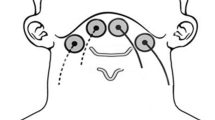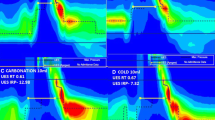Abstract
Transcutaneous electrical stimulation (TES) is a frequently used adjunctive modality in dysphagia rehabilitation. Stimulating deeper swallowing muscles requires higher TES amplitude. However, TES amplitude is limited by maximum amplitude tolerance (MAT). Previous studies have reported high interindividual variability regarding MAT and perceived discomfort. This variability might be one of the potential reasons of conflicting outcomes in TES-based swallowing studies. MAT and perceived discomfort are influenced by a variety of biopsychological factors. The influence of these factors related to swallow applications is poorly understood. This study explored the relation of biopsychological factors with MAT and perceived discomfort related to TES in the submental area. A convenience sample of thirty community-dwelling older adults between 60 and 70 years of age provided data for this study. Gender, submental adipose tissue thickness, perceptual pain sensitivity, and pain-coping strategies were evaluated for each subject. Subsequently, MAT and perceived discomfort level were determined using TES on the submental area. Relation of different biopsychological variables with MAT and discomfort level was examined using Pearson and Spearman correlation, and Mann–Whitney U test. Results indicated that neither gender nor adipose thickness was related to MAT and perceived discomfort. Among studied pain-coping strategies, catastrophizing was significantly related to MAT(r = – 0.552, p < .002). Distraction was significantly related to perceived discomfort level (r = − 0.561, p < 0.002). Given the negative impact of pain catastrophizing on MAT and the positive impact of distraction on perceiving discomfort, these coping strategies should be considered as amplitude-limiting and discomfort-moderating factors in TES-based dysphagia rehabilitation.
Similar content being viewed by others
References
Adams GR, Harris RT, Woodard D, Dudley GA. Mapping of electrical muscle stimulation using MRI. J Appl Physiol. 1993;74(2):532–7.
Alon G, Smith GV. Tolerance and conditioning to neuro-muscular electrical stimulation within and between sessions and gender. J Sport Sci Med. 2005;4(4):395–405.
Broderick BJ, Kennedy C, Breen PP, Kearns SR, Ol G. Patient tolerance of neuromuscular electrical stimulation (NMES) in the presence of orthopaedic implants. Med Eng Phys. 2011;33(1):56–61. https://doi.org/10.1016/j.medengphy.2010.09.003.
Barikroo A, Hegland K, Carnaby G, Bolser D, Manini T, Crary M. The effects of electrical stimulation pulse duration on lingual palatal pressure measures during swallowing in healthy older adults. Dysphagia. 2019. https://doi.org/10.1007/s00455-019-09991-y.
Berretin-Felix G, Sia I, Barikroo A, Carnaby GD, Crary MA. Immediate effects of transcutaneous electrical stimulation on physiological swallowing effort in older versus young adults. Gerodontology. 2016;33(3):348–55. https://doi.org/10.1111/ger.12166.
Barikroo A, Carnaby G, Bolser D, Rozensky R, Crary M. Transcutaneous electrical stimulation on the anterior neck region: the impact of pulse duration and frequency on maximum amplitude tolerance and perceived discomfort. J Oral Rehabil. 2018;45(6):436–41. https://doi.org/10.1111/joor.12625.
Denegar CR, Saliba E, Saliba SF. Therapeutic modalities for musculoskeletal injuries. 4th ed. Human Kinetics Illinois: Champaign; 2016.
Doucet BM, Lam A, Griffin L. Neuromuscular electrical stimulation for skeletal muscle function. Yale J Biol Med. 2012;85(2):201–15.
Piva SR, Goodnite EA, Azuma K, Woollard JD, Goodpaster BH, Wasko MC, Fitzgerald GK. Neuromuscular electrical stimulation and volitional exercise for individuals with rheumatoid arthritis: a multiple-patient case report. Phys Ther. 2007;87(8):1064–77. https://doi.org/10.2522/ptj.20060123.
Piva SR, Lasinski S, Almeida GJ, Fitzgerald GK, Delitto A. Association between psychosocial factors and dose of neuromuscular electrical stimulation in subjects with rheumatoid arthritis. Physiother Pract Res. 2013;34(2):57–66.
Chen YW, Chang KH, Chen HC, Liang WM, Wang YH, Lin YN. The effects of surface neuromuscular electrical stimulation on post-stroke dysphagia: a systemic review and meta-analysis. Clin Rehabil. 2015;30(1):24–35. https://doi.org/10.1177/0269215515571681.
Gatchel RJ, Peng YB, Peters ML, Fuchs PN, Turk DC. The biopsychosocial approach to chronic pain: scientific advances and future directions. Psychol Bull. 2007;133(4):581–624. https://doi.org/10.1037/0033-2909.133.4.581.
Racine M, Tousignant-Laflamme Y, Kloda LA, Dion D, Dupuis G, Choiniere M. A systematic literature review of 10 years of research on sex/gender and experimental pain perception—Part 1: are there really differences between women and men? Pain. 2012;153(3):602–18. https://doi.org/10.1016/j.pain.2011.11.025.
Gibson SJ, Farrell M. A review of age differences in the neurophysiology of nociception and the perceptual experience of pain. Clin J Pain. 2004;20(4):227–39.
Yunus MB, Arslan S, Aldag JC. Relationship between body mass index and fibromyalgia features. Scand J Rheumatol. 2002;31(1):27–31.
Al-Obaidi SM, Nelson RM, Al-Awadhi S, Al-Shuwaie N. The role of anticipation and fear of pain in the persistence of avoidance behavior in patients with chronic low back pain. Spine. 2000;25(9):1126–31.
McNeil DW, Au AR, Zvolensky MJ, McKee DR, Klineberg IJ, Ho CC. Fear of pain in orofacial pain patients. Pain. 2001;89(2–3):245–52.
Tang J, Gibson SJ. A psychophysical evaluation of the relationship between trait anxiety, pain perception, and induced state anxiety. J Pain. 2005;6(9):612–9. https://doi.org/10.1016/j.jpain.2005.03.009.
Vassend O. Anxiety, pain and discomfort associated with dental treatment. Behav Res Ther. 1993;31(7):659–66.
Reuter K, Classen CC, Roscoe JA, Morrow GR, Kirshner JJ, Rosenbluth R, Flynn PJ, Shedlock K, Spiegel D. Association of coping style, pain, age and depression with fatigue in women with primary breast cancer. Psycho-oncology. 2006;15(9):772–9. https://doi.org/10.1002/pon.1012.
Henningsen P, Lowe B. Depression, pain, and somatoform disorders. Curr Opin Psychiatry. 2006;19(1):19–24. https://doi.org/10.1097/01.yco.0000189880.11059.8d.
Auerbach SM, Laskin DM, Frantsve LM, Orr T. Depression, pain, exposure to stressful life events, and long-term outcomes in temporomandibular disorder patients. J Oral Maxillofac Surg. 2001;59(6):628–33. https://doi.org/10.1053/joms.2001.23371(discussion 634).
Rhudy JL, Meagher MW. Fear and anxiety: divergent effects on human pain thresholds. Pain. 2000;84(1):65–75.
Janssen SA. Negative affect and sensitization to pain. Scand J Psychol. 2002;43(2):131–7.
Meredith PJ, Strong J, Feeney JA. The relationship of adult attachment to emotion, catastrophizing, control, threshold and tolerance, in experimentally-induced pain. Pain. 2006;120(1–2):44–52. https://doi.org/10.1016/j.pain.2005.10.008.
Osman A, Barrios FX, Gutierrez PM, Kopper BA, Merrifield T, Grittmann L. The pain catastrophizing scale: further psychometric evaluation with adult samples. J Behav Med. 2000;23(4):351–65. https://doi.org/10.1023/A:1005548801037.
Meyers MC, Higgs R, LeUnes AD, Bourgeois AE, Laurent CM. Pain-coping traits of nontraditional women athletes: relevance to optimal treatment and rehabilitation. J Athl Train. 2015;50(10):1034–41. https://doi.org/10.4085/1062-6050-50.8.04.
Roth ML, Tripp DA, Harrison MH, Sullivan M, Carson P. Demographic and psychosocial predictors of acute perioperative pain for total knee arthroplasty. Pain Res Manag. 2007;12(3):185–94.
Kawashima K, Motohashi Y, Fujishima I. Prevalence of dysphagia among community-dwelling elderly individuals as estimated using a questionnaire for dysphagia screening. Dysphagia. 2004;19(4):266–71. https://doi.org/10.1007/s00455-004-0013-6.
Barikroo A, Berretin-Felix G, Carnaby G, Crary M. Effect of transcutaneous electrical stimulation amplitude on timing of swallow pressure peaks between healthy young and older adults. Gerodontology. 2017;34(1):24–32. https://doi.org/10.1111/ger.12221.
Ruscheweyh R, Marziniak M, Stumpenhorst F, Reinholz J, Knecht S. Pain sensitivity can be assessed by self-rating: development and validation of the pain sensitivity questionnaire. Pain. 2009;146(1–2):65–74. https://doi.org/10.1016/j.pain.2009.06.020.
Sellers AB, Ruscheweyh R, Kelley BJ, Ness TJ, Vetter TR. Validation of the English language pain sensitivity questionnaire. Reg Anesth Pain Med. 2013;38(6):508–14. https://doi.org/10.1097/AAP.0000000000000007.
Robinson ME, Riley JL 3rd, Myers CD, Sadler IJ, Kvaal SA, Geisser ME, Keefe FJ. The coping strategies questionnaire: a large sample, item level factor analysis. Clin J Pain. 1997;13(1):43–9.
Carlsson AM. Assessment of chronic pain. I. Aspects of the reliability and validity of the visual analogue scale. Pain. 1983;16(1):87–101.
Sullivan MJL, Bishop SR, Pivik J. The pain catastrophizing scale: development and validation. Psychol Assess. 1995;7(4):524–32. https://doi.org/10.1037//1040-3590.7.4.524.
Sullivan MJL, Rouse D, Bishop S, Johnston S. Thought suppression, catastrophizing, and pain. Cogn Ther Res. 1997;21(5):555–68. https://doi.org/10.1023/A:1021809519002.
France CR, France JL, al’Absi M, Ring C, McIntyre D. Catastrophizing is related to pain ratings, but not nociceptive flexion reflex threshold. Pain. 2002;99(3):459–63. https://doi.org/10.1016/S0304-3959(02)00235-X.
Sullivan MJL, Thorn B, Haythornthwaite JA, Keefe F, Martin M, Bradley LA, Lefebvre JC. Theoretical perspectives on the relation between catastrophizing and pain. Clin J Pain. 2001;17(1):52–64. https://doi.org/10.1097/00002508-200103000-00008.
Ruscheweyh R, Kreusch A, Albers C, Sommer J, Marziniak M. The effect of distraction strategies on pain perception and the nociceptive flexor reflex (RIII reflex). Pain. 2011;152(11):2662–71. https://doi.org/10.1016/j.pain.2011.08.016.
Brooks JC, Nurmikko TJ, Bimson WE, Singh KD, Roberts N. fMRI of thermal pain: effects of stimulus laterality and attention. NeuroImage. 2002;15(2):293–301. https://doi.org/10.1006/nimg.2001.0974.
Valet M, Sprenger T, Boecker H, Willoch F, Rummeny E, Conrad B, Erhard P, Tolle TR. Distraction modulates connectivity of the cingulo-frontal cortex and the midbrain during pain–an fMRI analysis. Pain. 2004;109(3):399–408. https://doi.org/10.1016/j.pain.2004.02.033.
Dezutter J, Wachholtz A, Corveleyn J. Prayer and pain: the mediating role of positive re-appraisal. J Behav Med. 2011;34(6):542–9. https://doi.org/10.1007/s10865-011-9348-2.
Funding
This study was partially supported by the National Center For Advancing Translational Sciences of the National Institutes of Health under Award Number UL1TR001427. The content is solely the responsibility of the authors and does not necessarily represent the official views of the National Institutes of Health.
Author information
Authors and Affiliations
Corresponding author
Ethics declarations
Conflict of interest
The authors declare that they have no conflict of interest.
Ethical Approval
All procedures performed in studies involving human participants were in accordance with the ethical standards of the institutional and/or national research committee and with the 1964 Helsinki declaration and its later amendments or comparable ethical standards.
Informed Consent
Informed consent was obtained from all individual participants included in the study.
Additional information
Publisher's Note
Springer Nature remains neutral with regard to jurisdictional claims in published maps and institutional affiliations.
Rights and permissions
About this article
Cite this article
Barikroo, A., Hegland, K., Carnaby, G. et al. Transcutaneous Electrical Stimulation on the Submental Area: The Relations of Biopsychological Factors with Maximum Amplitude Tolerance and Perceived Discomfort Level. Dysphagia 35, 301–307 (2020). https://doi.org/10.1007/s00455-019-10029-6
Received:
Revised:
Accepted:
Published:
Issue Date:
DOI: https://doi.org/10.1007/s00455-019-10029-6




